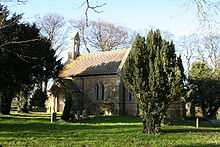William Adams Nicholson
William Adams Nicholson (1803–1853) was an English architect.
Life
Born on 8 August 1803 at Southwell, Nottinghamshire, he was the son of James Nicholson, carpenter and joiner. James gave up his business about 1838 and became sub-agent to Sir Richard Sutton's estates in Nottinghamshire and Norfolk. William was articled about July 1821, for three years, to John Buonarotti Papworth, architect, of London. In 1828 he established himself at Lincoln; and there and in the neighbouring counties he built up an extensive practice. From 1839 to 1846 he was in partnership as Nicholson & Goddard, with Henry Goddard (1813–1899).[1][2] Charles Baily was a pupil.[3]
Nicholson joined the Royal Institute of British Architects as a founding fellow at its commencement. He was a member of the Lincolnshire Literary Society, and of the Lincolnshire Topographical Society. He was in attendance at Boston as a professional witness when he was suddenly taken ill, and died there on 8 April 1853. He was buried at Lincoln, in the churchyard of St. Swithin, in the parish where he had resided for many years.[1]
Works

Nicholson designed the churches at Glandford-Brigg, at Wragby, and at Kirmond, on the estate of C. Turnor. Many other churches were restored under his supervision, including St. Peter at Gowts' Church, Lincoln, not quite complete at his death. Among residences erected from his designs were those of Worsborough Hall, Yorkshire; the Castle of Bayons Manor for Charles Tennyson d'Eyncourt; and Elkington Hall, near Louth. He also designed the town-hall at Mansfield. The village of Blankney, near Lincoln, was almost rebuilt under his superintendence. He put up farm buildings on the estates of General Reeve, Sir John Wyldbore Smith, bart., C. Turnor, C. Chaplin, and others.[1]
In Lincoln Nicholson erected in 1837 the Wesley Chapel, for two thousand persons, and subsequently designed the union workhouse; also the Corn Exchange in 1847, later enlarged, a corn-mill, and several private residences. The firm carried out many other works, including the dispensary at Nottingham.[1]
Family
In 1824 Nicholson married Leonora, the youngest daughter of William Say of Norton Street, London. His second wife, Anne Tallant, survived him.[1]
References
- ↑ 1.0 1.1 1.2 1.3 1.4
 "Nicholson, William Adams". Dictionary of National Biography. London: Smith, Elder & Co. 1885–1900.
"Nicholson, William Adams". Dictionary of National Biography. London: Smith, Elder & Co. 1885–1900. - ↑ Saur allgemeines Künstlerlexikon. Walter de Gruyter. 1992. p. 371. ISBN 978-3-598-22740-0. Retrieved 27 September 2012.
- ↑ Peach, Annette. "Baily, Charles". Oxford Dictionary of National Biography (online ed.). Oxford University Press. doi:10.1093/ref:odnb/1075. (Subscription or UK public library membership required.)
| Wikimedia Commons has media related to William Adams Nicholson. |
- Attribution
![]() This article incorporates text from a publication now in the public domain: "Nicholson, William Adams". Dictionary of National Biography. London: Smith, Elder & Co. 1885–1900.
This article incorporates text from a publication now in the public domain: "Nicholson, William Adams". Dictionary of National Biography. London: Smith, Elder & Co. 1885–1900.